Prabhat Pattan
| Author:Laxman Burdak, IFS (R) |
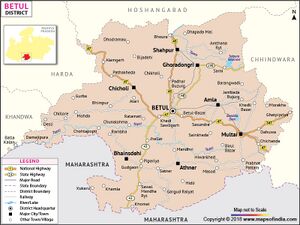
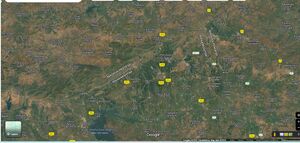
Prabhat Pattan (प्रभात पट्टन) is a town and tahsil in Betul district in Madhya Pradesh. Earlier it was included in Multai tahsil. Author (Laxman Burdak) visited it on 15.02.1994, 04.07.1994.
Variants
- Prabhatpattan (प्रभातपट्टन)
- Prabalapura (प्रबलपुर)
- Ashvatthakheta (अश्वत्थखेट)/Ashvatthakhetaka (अश्वत्थखेटक)/Asvatthakhetaka (अश्वत्थखेटक): The name of the village Asvatthakhetaka (अश्वत्थखेटक), mentioned in Pattan Plates of 27th year of Pravarasena II[1], in which the donated land was situated, can no longer be traced; its site seems to be occupied by the modern village Pattan (पट्टन) or Prabhat Pattan (प्रभात पट्टन) in Betul district of Madhya Pradesh.
Origin
Location
Prabhatpattan is a Town in Prabhat Pattan Tehsil in Betul District of Madhya Pradesh State, India. It belongs to Narmadapuram Division . It is located 57 KM towards East from District head quarters Betul. It is a Tehsil head quarter. Prabhatpattan Pin code is 460665 and postal head office is Prabhat Pattan. Godhani ( 4 KM ) , Mangonakala ( 5 KM ) , Tiwarkheda ( 6 KM ) , Mangonakurd ( 6 KM ) , Narkhed ( 7 KM ) are the nearby Villages to Prabhatpattan. Prabhatpattan is surrounded by Multai Tehsil towards North , Warud Tehsil towards South , Pandhurna Tehsil towards East , Amla Tehsil towards North.[2]
Pattan Plates of 27th year of Pravarasena II
[p.57]: These plates were discovered at Pattan (पट्टन), a village in the Multai tahsil of the Betul District in Madhya Pradesh. They were turned up in a field by the plough of a farmer in 1935. They were later acquired for the Central Museum, Nagpur, where they are now deposited. I edited them with facsimiles in the Epigraphia Indica, Vol. XXIII, pp. 81 f. They are edited here from the same facsimiles.
The copper-plates are five in number, of which the first and the last arc inscribed on one side only and the remaining three on both the sides. Each plate measures 6.9" by 4" and is about .1" in thickness. The ends of the plates are neither fashioned thicker nor raised into rims for the protection of the writing.....The weight of the plates is 134 tolas and that of the seal 8.1/2 tolas. The plates are not now in a good state of preservation. Their surface, which originally was not made quite smooth, has been further damaged by rust. Many letters in the right half of line 45 and most of those in the two following lines have been almost obliterated by friction, but can be read, though with some difficulty, from the traces left on the plate. Each inscribed surface contains six lines, except the first side of the third plate which has only five lines inscribed on it. The seal contains the usual Vakataka legend in verse, inscribed in four lines.
The characters are of the box-headed variety of the southern alphabets. ....The language is Sanskrit. Except for the legend on the seal and the customary benedictive and imprecatory verses at the end, the whole record is in prose. It abounds in mistakes of orthography, sandhi, syntax, declension, conjugation, verbal and nominal derivatives etc., most of which must be attributed to the ignorance or carelessness of the writer. As regards mistakes of orthography, we may note the use of the short for the long vowel as in sunoh, line 4, of ri for the vowel ṛi and of li for the vowel ḷi as in Prithivi- line 14 and klipt-opakliptah in line 33; in many cases the rules of sandhi have been violated; cf. guṇai samupetasya, line 12; For mistakes of declension, see such forms as pūrvvāyā, line 25, and for those of declension see kārayīta, line 36, and kuryyāmah, line 37. As an instance of wrong verbal derivatives, see kārāvaka, lines 46-47 and for that of nominal derivatives, notice
[p.58]: rājakya for rajakīya), line 22. The writer has violated an elementary rule of concord in in sutāyāḥ Prabhavatiguptāyām, line 17 and of compounding in murdhn-ābhishiktānān-, line 7. As regards orthographical peculiarities sanctioned by Sanskrit grammar, we may notice that consonant preceding r and y is doubled in parākkrama-, line 6, and sarvvāddhyaksha, line 24, and that following r is similarly reduplicated in varddhamāna-, line 13.
The inscription, which opens with drishtam, is one of the [[Vakataka Maharaja Pravarasena II. His genealogy is given here as in his other plates, his maternal grandfather being called Devagupta. The object of the present plates, which were issued from Pravarapura1, is to record the grant of 400 nivartanas of land, by the royal measure2, in the Asvatthakhetaka (अश्वत्थखेटक) for the maintenance of a sattra or charitable feeding house in honour of the foot-prints of Mahapurusha (Vishnu)3. The village was situated in the mārga of Varadakheta (वरदाखेट) included in the division (bhoga) of Lohanagara (लोहनगर). The gift was made at the request of Narayanaraja (नरायणराज). The charter was written on the seventh day of the dark fortnight of Karttika in the twenty-seventh (regnal) year. The scribe was Kalidasa (कालीदास) who was serving under the Senapati Katyayana (कात्यायन). The record as engraved by the goldsmith Isvaradatta (ईश्वरदत्त), who was a servant of Kaundaraja (कौण्डराज). It is stated at the end that Pitamaha (पितामह) and Nanda (नन्द) caused the charter to be drafted.
The present plates furnish the last but one date so far known of Pravarasena II's reign. The mention of Pravarapura as the place of issue shows that the city continued to be the royal capital to the end of his reign. Kaundaraja whose servant Isvaradatta incised the present charter is evidently identical with Kondaraja, the son of Shatrughnaraja, at whose request the grant recorded in the Chammak plates was made4
The mention of Kalidasa (कालीदास) in the present grant raises the interesting question of his identity with the illustrious Sanskrit poet of that name. The latter is generally placed in the Gupta period, but the earliest epigraphical mention of his name occurs in the Aihole prasasti of Pulakesin II, dated Saka 556 (634 A.C.)5. This is the first time that the name Kalidasa has been discovered in a record of the Gupta period.
Kalidasa, no doubt, figures only as a scribe in the present grant, but that does not per se disprove his identity with the great Sanskrit poet. Such charters were generally drafted and written on copper-plates by clerks working in the office of the Sāndhivigrahika or Minister for peace and war, but sometimes we find even great officers mentioned as writers of such documents. Thus the writer of the Tirodi plates of Pravarasena II was the Chief Minister (Rājyddhikrita) himself6. Again, according to a tradition recorded by Ramadasa, a commentator of the Setubandha, Kalidasa composed the Prakrit kāvya for Pravarasena by the order of Vikramaditya7 This he must have done during his sojourn in Vidarbha. The idea of writing the Meghaduta seems to have suggested itself to the poet’s mind at Ramtek near Nagpur (Ramagiri of the Meghaduta), which we know was a holy place visited by the
1 Since the grant was made at the capital, the expression vaijayike sthaneoccurs in it as it does in other Vakataka grants made at the capital.
2 The same expression occurs in the Wadgaon plates (No. 12). See also Rajamānika in No. 6 line 18. There may have been local measures called vishaya-mana. Cf. Sankheda plates of Dadda II (CII, Vol. IV, p. 77).
3 For a similar grant of a slightly later period, see the Podagadh inscription, Ep. Ind Vol XXI p. 156. For Mahapurusha or Mahapurusha meaning Vishnu, see the Bhagavata Purana II, 1, 10; V, 15, 4 and 6; 17, 16-17; VIII, 6, 32, etc.
4 See No. 6, line 19.
5 Ep. Ind, Vol. VI, pp. 1 f.
6 No.11, line 32.
7 Nirnayasagar Press ed., p. 3; sec also the colophon of the last canto.
[p.59]: Vakatakas1. It is not unlikely that while in Vidarbha, Kalidasa was attached to the office of the Senapati as stated in the present record. He may therefore be identified with the writer of this grant.
But a close examination of the present record shows that this view is untenable. The scribe of the present plates had a very imperfect knowledge of Sanskrit. As pointed out above, there are numerous orthographical and grammatical mistakes, for most of which the writer, not the engraver, must have been responsible. On the other hand, Kalidasa had a great command over the Sanskrit language. He has emphasised the importance of correct speech in one of his similes2, and his works contain fewer instances of solecisms than those of his predecessors and successors. It is incredible that such a great poet as Kalidasa would commit so many mistakes of orthography, sandhi, syntax, nominal and verbal forms, etc., which disfigure the present record. Disappointing as it is, one has to admit that the scribe was only a namesake and a contemporary of, but not identical with, the prince of Sanskrit poets. We may note here that similar names ending in dasa were current in Vidarbha in the age of the Vakatakas. Thus we know of Namidasa, a Senapati, Chamidasa, the Chief Minister, as well as the writers Chakradasa, Goladasa and Maradasa.
As for the localities mentioned in the present grant,
Varadakheta (वरदाखेट) is probably Warud in the Morshi tahsil of the Amravati District, about 12 miles south of Pattan (पट्टन).
Lohanagara (लोहनगर), the headquarters of an ancient division, may be represented by Loni, about 9 miles southwest of Warud.
The name of the village Asvatthakhetaka (अश्वत्थखेटक), in which the donated land was situated, can no longer be traced; its site seems to be occupied by the modern village Pattan (पट्टन). Tradition says that the ancient village, the site of which is now included in Pattan (पट्टन), was turned upside down and buried underground by the curse of a Muslim saint Sulaiman Shah3. Even now, when excavations are made, large-size bricks, beads of onyx and old coins are found there, which also shows that the modern village is occupying an old site. It may, again, be noted that Pattan (पट्टन) lies on the way from Multai to Warud (ancient Varadakheta), and may, therefore, have been included in the mārga (territorial division) of Varadakheta.
1 No. 8, line 1.
2 Kumārasambhava, canto I, v. 27.
3 Betul District Gazetteer, p. 256.
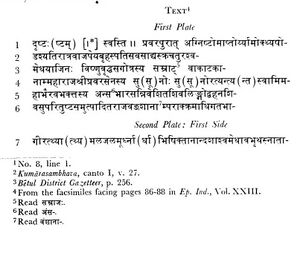
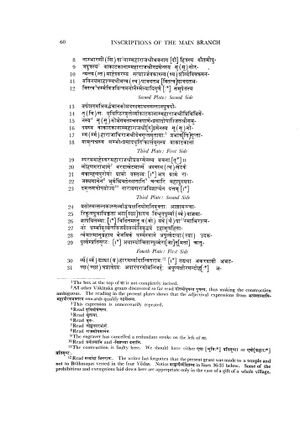
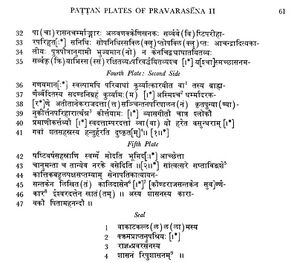
[p.61]: Seen. Hail! From Pravarapura —
By the order of the illustrious Pravarasena (II), the Maharaja of the Vakatakas, and a devout worshipper of Maheshvara, who, by the grace of Shambhu, has established the Kritayuga (Golden age) (on the earth), who was born of Prabhavatigupta, the daughter of the Maharajadhiraja, the illustrious Devagupta, (and) who is the son of the illustrious Rudrasena (II), the Maharaja of the Vakatakas —
(The residents of) the village led by the Brahmanas in Ashvatthakhetaka (अश्वत्थखेटक) in the mārga of Varadakheta (वरदाखेट) (included) in the bhoga of Lohanagara (लोहनगर), should be addressed as follows:—
[p.62]: In this village we have donated, at the request of Narayanaraja (नारायणराज), four hundred nivartanas of land by the royal measure, to be utilised for the charitable feeding house (attached to the temple of) Mahapurusha (Vishnu).
(Line 39). And the following two verses sung by Vyasa should be regarded as authoritative on this point: —
(Line 43;. (This charter has been) written by Kalidasa (कालीदास), a servant of the Senapati Katyayana (कात्यायन) on the seventh (lunar day) in the dark fortnight of karttika in the twenty-seventh (regnal) year. (It has been) engraved by the goldsmith Isvaradatta (ईश्वरदत्त), a servant of Kondaraja (कोण्डराज). The executors of this (royal) charter are Pitamaha (पितामह) and Nanda (नन्द).
Wiki Editor Notes
- Kondal (कोन्डल) (Jat clan) = Kondaraja (कोण्डराज). Kondaraja (कोण्डराज) is mentioned in Pattan Plates of 27th year of Pravarasena II[3] Pattan or Prabhat Pattan is a town and tahsil in Betul district in Madhya Pradesh.
- Loh (लोह) (Jat clan) = Lohanagara (लोहनगर) = Loni (लोनी). Loni (लोनी) is a village in Warud tahsil in Amravati district of Maharashtra, India. Loni is mentioned as Lohanagara (लोहनगर) in Pattan Plates of 27th year of Pravarasena II[4]
- Lon (लोन) (Jat clan) → Loni (लोनी) = Lohanagara (लोहनगर). Loni (लोनी) is a village in Warud tahsil in Amravati district of Maharashtra, India. Loni is mentioned as Lohanagara (लोहनगर) in Pattan Plates of 27th year of Pravarasena II[5]
- Wardak (वरडक) (Jat clan) = Varadakheta (वरदाखेट) = Warud (वरुड). Warud (वरुड) is a town and tahsil in Amravati district of Maharashtra, India. Varadakheta (वरदाखेट) is mentioned in Pattan Plates of 27th year of Pravarasena II[6]
History
People
प्रभात पट्टन
प्रभात पट्टन भारत के मध्य प्रदेश राज्य के बैतूल जिले की प्रमुख तहसील है। इसका प्राचीन नाम प्रबलपुर है। इसके उत्तर में ताप्ती नदी का पवित्र उद्गम स्थल मुलताई है एवं दक्षिण में महाराष्ट्र राज्य का अमरावती जिले की वरूड तहसील स्थित है एवं पूर्व में पांडुरना तहसील स्थित है। यहां की कुल आबादी 20000 है। यहां पर अनेक स्वतंत्रता संग्राम सेनानी होने के कारण इसे वीरों की नगरी भी कहा जाता है। यहां हिंदू तथा मुस्लिम धर्म के प्रमुख सांस्कृतिक एवं धार्मिक स्थल है। यहां बैतूल जिले की प्रमुख शिक्षा केंद्र डाइट एवं जवाहर नवोदय विद्यालय स्थित है।
External links
See also
References
- ↑ Corpus Inscriptionum Indicarum Vol.5 (Inscriptions of The Vakatakas), Edited by Vasudev Vishnu Mirashi, 1963, Archaeological Survey of India, p.57-62
- ↑ https://www.onefivenine.com/india/villages/Betul/Prabhat-Pattan/Prabhatpattan#google_vignette
- ↑ Corpus Inscriptionum Indicarum Vol.5 (Inscriptions of The Vakatakas), Edited by Vasudev Vishnu Mirashi, 1963, Archaeological Survey of India, p.57-62
- ↑ Corpus Inscriptionum Indicarum Vol.5 (Inscriptions of The Vakatakas), Edited by Vasudev Vishnu Mirashi, 1963, Archaeological Survey of India, p.57-62
- ↑ Corpus Inscriptionum Indicarum Vol.5 (Inscriptions of The Vakatakas), Edited by Vasudev Vishnu Mirashi, 1963, Archaeological Survey of India, p.57-62
- ↑ Corpus Inscriptionum Indicarum Vol.5 (Inscriptions of The Vakatakas), Edited by Vasudev Vishnu Mirashi, 1963, Archaeological Survey of India, p.57-62

